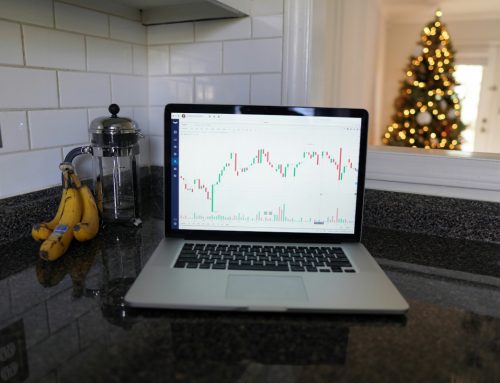Don’t have the time to analyze stocks daily, but want short-term or mid-term gains on your trades? Sounds like swing trading is the perfect strategy for you. It’s less time-consuming than day trading. It’s far more simple, too. The best part? You still maximize short-term profit potential by taking advantage of market swings.
First and foremost, though, what is swing trading? And how does swing trading work?
You’ve got questions, and we’ve got answers.
We’re going to provide you with a quick introduction to this trading strategy. You’ll learn what exactly defines this type of trading – along with the pros and cons associated with it. Then, we’ll explain how swing trading works. Towards the end, we’ll uncover the #1 way to get started with a high rate of success.
What Is Swing Trading?
We’ll begin by addressing the question that brought you here today – what is swing trading?
This phrase simply refers to a trading strategy in which the trader looks to attain short or medium-term gains. That’s right, if you’re looking for short to medium-term gains, you’re a swing trader and may not even know it. The key is whether your investing strategy in practice follows your goals.
Typically, trades are executed over the course of a few days – or in some cases, a few weeks. Swing traders don’t look at intraday price movement – instead, they look at medium-term price swings. The name “swing” comes from the swings in price at which a trader will enter or exit a stock that allows them to attain short to medium-term gains based on market momentum.
When swing trading, you won’t look so much at a stock’s fundamental or intrinsic value when making decisions. Instead, most swing traders rely entirely on technical analysis. Following patterns and timing the market is how you’ll achieve success through this strategy. This sounds complicated and time-consuming but with the right tools, the work is often done for you, you just have to execute the trades.
If you’ve been an investor for a while now, you’re probably thinking to yourself – wait, you can’t time the market. Nobody really has that power, right?
Wrong. This is one of the most common myths in the trading world. Timing the market is as simple as following trends with the help of mathematical models. Or as some may call it, data-driven investing.
In fact, timing the market is relatively easy and can be done with a high rate of accuracy. It just takes the right expertise and software. We’ll talk more about timing when we discuss how swing trading works. First, we’ll explain the advantages and disadvantages of this trading technique.
What Are The Advantages Of Swing Trading?
There is a reason swing trading is one of the most popular strategies traders use. It’s simple, doesn’t take much time, and generates immediate profit potential that can generate supplemental income..
For beginner traders, this is a great strategy because you’ll have fewer working parts factoring into your decisions. You’ll just need to learn how to analyze technical information. But as you’ll soon learn, even this can be automated through technology. There is stock trading software that simplifies things even further.
Sure, swing trading will take up more time than long-term trading. But compared to day trading, the time commitment is minuscule. This strategy just requires a bit of daily technical analysis – much of which can be simplified through software. This means you can spend your mornings analyzing and your afternoons doing whatever it is you enjoy. Or – you can swing trade part-time while working your 9-5 job since you’re not staring at charts all day until the market closes as you might with day trading.
And, of course, swing traders enjoy a good return on their investment. This strategy can be highly profitable with minimal risk. You just have to be consistent – and you’ll enjoy returns anywhere from 10-50% over the course of a year.
What Are The Disadvantages Of Swing Trading?
There are all sorts of advantages associated with swing trading. But it’s not all sunshine and rainbows. There are a few drawbacks you should be aware of, too.
One of the most noteworthy is that swing traders are exposed to overnight and weekend price changes. There is a certain level of risk because you don’t always close out your position at the end of the day or week. Should negative earnings reports or other market news come in after hours, you will feel it in the morning when the market opens. Your stop loss will more or less be useless in these scenarios.
You’ll also have to consider the potential lost opportunities you’d have gained from holding a stock long term. There will be instances where you may close your position at the perfect time to capture profit. This is great – but over the course of 6 months or a few years, that stock may have risen an additional 25-50%.
A third and final disadvantage of this style of trading is the difficulty with market timing. We previously stated that market timing is entirely possible – but that doesn’t mean it’s easy, especially for novice traders trying to do it on their own. That’s why it is so important that you find the right stock trading software. To date – there is just one software that provides accurate marketing timing. We’ll share it with you towards the end.
How Does Swing Trading Work?
Now that you know what swing trading is, your next question is probably “how does swing trading work?”. And like we’ve said – the strategies behind this type of trading are pretty simple. With the right trading platform, it’s even simpler. But before you can get started as a swing trader, you need to understand risk.
Understanding The Importance Of Risk Management
If you’re new to trading in general, it’s important to understand that you aren’t going to win every trade. Before beginning, assess your risk tolerance. If you’re looking for high returns, you’ll have to take higher risks. Similarly, you can play it safe and minimize your risks – but you’ll earn smaller returns.
To help you manage your risk, you should ensure that your portfolio is heavily diversified. We don’t recommend you keep more than 10% of your portfolio in any single stock. The more diversified you are, the less you’ll feel it if one of your stocks tanks before you can close your position. To manage risk even further, look to diversify your stocks in terms of different sectors and different capitalizations. If all your stocks fall under the same umbrella, you’re not necessarily diversified.
You can’t truly manage your risk without setting stop losses. These are orders you place to sell off your position if a stock falls below a certain price. With stop losses in place, you always know the maximum level of risk you face.
With all this said, swing trading can be a pretty low-risk strategy when implemented correctly. With a bulletproof strategy and emotionless decision-making, you’ll win more than you’ll lose and come out on the right side of things. But to truly set yourself up for success, you need to rely on the right strategies.
A Quick Introduction To Swing Trading Strategies
There are quite a few different strategies swing traders can employ. When we talk about strategies, we’re talking about forms of technical analysis. And, the most successful swing trader is one who relies on multiple strategies to help make informed decisions. Here are some of the most common strategies:
- Setting triggers based on support (lower level of a price range) and resistance (upper level of a price range) levels
- Analyzing moving averages overload on daily or weekly charts
- Using the Fibonacci retracement pattern. This is a great way to help you identify possible reversals in a stock’s price
We have a complete guide on swing trading strategy. We also recently broke down the best indicators for swing traders. If you’re looking to gain a better understanding of technical analysis, and how to actually execute your trading strategy, these are two great resources.
For now, let’s talk about the #1 way to set yourself up for success as a swing trader: finding the right forecasting software.
Choosing The Right Stock Forecasting Software For Swing Traders
In any stock forecasting software, you’ll have indicators you can look at that help you analyze a given stock. But, most swing traders want things simplified. There are so many different angles from which you can evaluate a stock that it’s easy to overthink. That’s why you should find a stock trading platform that helps you make sense of the numbers.
VectorVest is the most simple, intuitive stock prediction tool on the market. This stock forecasting software is unlike anything you’ve experienced before. We do something no one else has been able to do: time the market with a high rate of accuracy. And, we give you a clear buy, hold, or sell recommendation for any given stock – and even help you gain an understanding of market sentiment as a whole.
Our system works through proprietary value, safety, and timing metrics. These three metrics simplify all other metrics so you only get the information you really need. Plus, we have proprietary screeners working to find the hottest stocks at any given time.
Through the VectorVest platform, you’ll gain more confidence in executing your trades. But more importantly, you’ll effectively manage risk and maintain a high level of profitability. If you want to analyze your own stocks, we’ve got all the indicators and tools you need to do so. If you want a brain-dead easy approach to trading, we’ll tell you which stocks to buy. It can be as easy or sophisticated as you like. For an inside peek at what a stock analysis looks like, get your free stock analysis.
Final Thoughts On What Swing Trading Is & How It Works
Well, there you have it – this is the first step in your journey as a swing trader. We’ve answered basic questions like “what is swing trading?” and “how does swing trading work?”. In summary, this is a short-term to mid-term approach to trading in which you take advantage of the “swings” in a stock’s price to achieve short-term gains and supplement income. You’ll use indicators and other forms of technical analysis to identify opportunities.
At this point, all that’s left to do is give it a try yourself. With VectorVest, you can hit the ground running at a high rate of success. And with transparent flat-rate monthly fees, you won’t get hit with hidden costs. You can give this system a shot today 100% risk-free with a 30-day trial.
What you should do next…
- Get our latest blogs delivered right to your inbox, subscribe to our newsletter.
- The market moves fast! Get our most current evaluation of this stock with our FREE stock analysis tool.
- Looking for stock picks? Not sure if now is the right time to buy/sell? For a limited time, enjoy the full benefits of a 30-day subscription to VectorVest for only $9.95 (usually up to $139/month) . Get access to our full list of screeners showcasing our top stock picks that tell you exactly what to buy, when to buy, and when to sell.









Leave A Comment